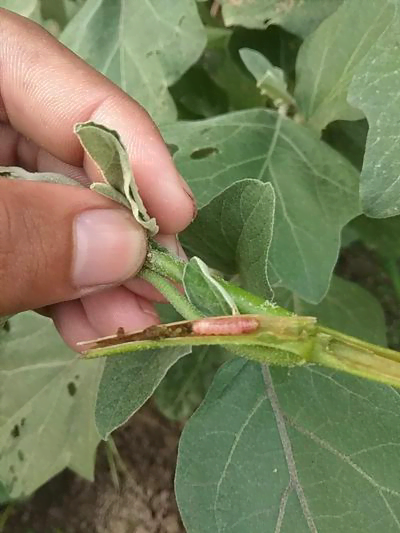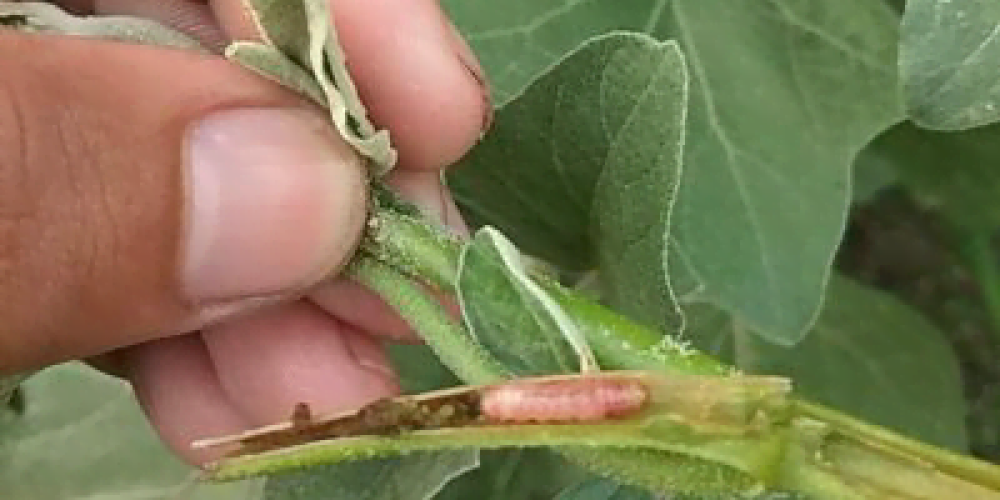Table of contents of the article
ToggleThe eggplant shoot and fruit borer is a serious pest that directly affects the plant’s productivity. In this article from “WORLD OF PLANTS,” we discuss the most important symptoms of infection and methods of effective prevention and control of this pest.
Symptoms of eggplant shoot and fruit borer disease
Symptoms of the disease appear as signs of feeding on flowers and buds. This is followed by the wilting of the tips of the growing shoots and stems, as well as the presence of entry and exit holes closed by dry feces on the fruit, as well as the presence of hollow fruits filled with feces. •
The larvae are pink with a brown head.

•The first visible symptom is the wilting of the beginnings of the buds as a result of early caterpillars feeding on them, then the flowers, flower buds and stems are also affected. “Adult larvae puncture the mid-vein terminal portion of large leaves and developing buds to penetrate the stem and cause damage to the plant core.” The mature larvae penetrate the fruits and leave the small entry holes closed with their dry feces. The fruit cavity becomes distorted and filled with a yellow secretion. Wilting and weakening of the plants may occur in the event of a severe infestation, causing loss of the crop or the fruits produced by these plants that may be unfit for consumption. The damage is More severe when a large number of insects accumulate over several generations
The cause of eggplant shoot and fruit borer disease
The larvae of the Lysindus orbonalis moth cause damage. In the spring, females lay creamy white eggs singly or in groups on the undersides of leaves, on stems, flower buds, or the base of fruit. The larvae then hatch after 3 to 5 days and are usually deposited directly in the fruit. The developing caterpillar is plump and firm, pink in color with a brown head. When feeding is complete, pupation occurs in a hard, woven cocoon on stems, dry shoots, or among fallen leaves. The pupation stage lasts from 6 to 8 days, after which adult insects appear, and adult butterflies live for two days. To five days, to complete a life cycle that lasts from 21 to 43 days depending on environmental conditions, and there can be up to five overlapping generations in its active phase per year, and during the winter the larvae hibernate inside the soil.
Suitable conditions for eggplant shoot and fruit borer disease
The eggplant stem borer infects the Solanaceae family market, and its infestation is most severe in areas that grow pepper or sterilized eggplant, where the pupal insect spends the winter period in infected plant remains or sterilized plants.
The infestation of this insect is most common in the winter crop, but the infestation is very low in the summer crop. The infestation is observed in the potato crop that is uprooted in January and in barns equipped for storing and preparing potatoes.
Controlling eggplant shoot and fruit borer disease
- Remove infected branches, plants or tubers and destroy them, including their larvae
- Use the infected stems after cutting the crop for fuel and do not leave them for the following year, as they contain dormant larvae.
- Do not sterilize peppers and eggplant in potato growing areas
- The insect is controlled as in the potato tuber worm recommendations, with spraying directed at the bases of the plant stems
Organic control of eggplant shoot and fruit borer disease
Several parasites feed on the larvae of Orbonalis, such as Burstamrus testasius, Cremistas flavourptales, and Charcoa chornobicum. Species such as Cytodium perchata, Bracondus, and Vanrotoma should be developed and introduced into the field. Neem seed kernel extract (NSKE) with 5% or spinosad can also be used on infected fruits. Nets containing sticky materials such as glue can be used at a height of 10 cm facing outward to avoid laying eggs. If glue is not available, stretch the net 40 cm wide at a height of 2 metres, then allow it to drape outward at an angle of 80-85 degrees against the vertical net. .
Chemical control of eggplant shoot and fruit borer disease
Always consider an integrated approach with preventive measures together with biological treatments if available. Sevemol (0.1%), or malathion (0.1 %) can be sprayed at regular intervals to keep mite infestations under control, and avoid the use of synthetic pyrethroids and insecticides. At the time of fruit ripening and harvest.
Preventive measures for eggplant shoot and fruit borer disease
You should plant resistant or tolerant plant varieties if they are available in your area.
You can also practice mixed farming with other host crops such as fennel, um, coriander, and black seed, if possible for two seasons.
You must monitor the field regularly in anticipation of the appearance of symptoms of the disease. Fallen leaves, buds, or fruits must be collected and destroyed at a distance from the field. The ground must be kept clean of fallen fruits, leaves, and buds. In the event of a severe infestation, the entire plant must be uprooted and destroyed.
Use nylon mesh barriers to prevent moths from migrating to other crops or fields, and also use pheromone traps to attract or catch moth populations.
In conclusion, we would like to note that we, at the world of plants website, offer you all the necessary services in the world of plants, we provide all farmers and those interested in plants with three main services::-
- Artificial intelligence consulting service to help you identify diseases that affect plants and how to deal with them.
- Blog about plants, plant diseases and care of various crops ... You are currently browsing one of her articles right now.
- An application that provides agricultural consultations to clients, as well as a service for imaging diseases and knowing their treatment for free – Click to download the Android version from Google Play Store، Click to download the IOS version from the Apple App Store.
sources:-




